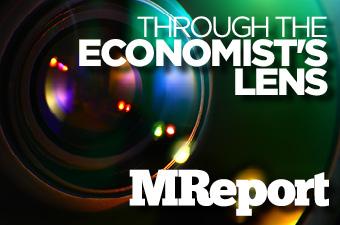President Obama unleashed a predictable firestorm when he proposed during the State of the Union address that the minimum wage be increased to $9.00 an hour from the current $7.25.
[IMAGE]The reactions were expected: conservative economists criticizing the suggestion while progressives either endorsed it outright or noted the proposal was less than the $9.50 minimum wage proposed by then-candidate Obama.
The president received his biggest boost from an unlikely source: Wal-Mart Stores Inc, despite a profitable first quarter, cut its forecast for the year, and Burger King slashed the price of its Whopper Jr. from $2.00 to $1.29, both acknowledging an expected hit from the end of the payroll tax holiday at the beginning of the year. That holiday lopped two percentage points off the employee contribution to Social Security, reducing take home pay by about $1,300 a year per salaried worker and dropping spending by $110 billion, a severe hit to an economy built on consumer spending.
Economic studies are split on the impact of an increase in the minimum wage on employment and unemployment. Economists David Card of Berkeley and Alan Krueger of Princeton studied changes following increases in the minimum wage in New Jersey in 1992 and California in 1998 and found no evidence the boost in the minimum wage caused any drop in employment when they compared trends to areas which had no increase in the minimum wage.
On the other side, UC Irvine's David Neumark and the Federal Reserve's William Wauscher, conducting not a statistical study but a ""literature review,"" found a majority of studies held determined negative effects on employment: A higher minimum wage meant fewer jobs.
If that argument were true, it should follow that reducing the minimum wage would increase employment. Fat chance--employers, whether they realize or not, use a simple analysis in hiring: revenue or profit per employee. To be sure, lower wages might increase the profit per employee, but lowering wages--say, by eliminating the minimum wage entirely--would not increase revenues. It would more likely reduce revenues with fewer consumers.
[COLUMN_BREAK]That suggest perhaps the economists--both sets--were looking through the wrong end of the telescope.
Higher wages will increase purchasing power and therefore consumption, a critical factor in an economy in which consumption makes up 70 percent of GDP. More significantly, the minimum wage worker is more likely to spend most, if not all, of his or her marginal income, increasing the impact of the boost in the minimum wage.
Indeed, the main effect of a higher minimum wage is to raise the incomes of the lowest paid workers, which in turn means increased spending and increased growth.
Economic data for the week ending February 22--particularly for housing--was less than encouraging. ""A small increase"":https://themreport.com/articles/existing-home-sales-inch-up-as-prices-hit-10-month-low-2013-02-21 in existing-home sales was the only bright spot, but that was weighed down by another drop in the median price of existing single-family homes to their lowest level in 10 months. The word ""another"" is critical because it means the drop in inventory in December did not result in higher prices. Indeed, the supply of homes for sale fell again in January, this time to the lowest level in 13 years.
Builders aren't picking up the slack as new ""housing starts fell in January"":https://themreport.com/articles/housing-starts-dive-in-january-permits-reach-4-1-2-yera-high-2013-02-20. While multifamily starts pulled down the construction data, the increase in single family starts was microscopic even if it did push starts to the highest level since July 2008. In July 2008, the seasonally annual adjusted rate of states was 615,000, only about one-third of what was in January 2006 when builders broke ground on new homes at the rate of 1,823,000 annually.
The key numbers for the upcoming week will include:
The ""Case-Shiller Home Price Index"":http://www.standardandpoors.com/indices/sp-case-shiller-home-price-indices/en/us/?indexId=spusa-cashpidff--p-us---- for December (to be released Tuesday) is expected to show a slight pickup in the 20-city index despite the movement in existing-home prices. The consensus forecast is a 6.6 percent year-over-year gain compared with 5.5 percent reported for November.
The ""Census Bureau"":http://www.census.gov/ will report Tuesday on new home sales for January. Economists expect the report to show an annualized rate of 380,000 sales (that is, contracts for sale), up from 369,000 in December. New home sales continue, however, to significantly lag housing completions.
Thursday's report on GDP is expected to show the economy actually expanded in the fourth quarter, reversing the ""advance"" report ""a month ago"":https://themreport.com/articles/gdp-falls-in-4q-first-drop-since-recession-ended-2013-01-30 that showed a contraction. The expansion, such as it is, is expected to be just 0.5 percent. The ""good news"" could be temporary, though, with the first quarter expected to be battered by lower consumer spending and the impact of sequestration to cut federal spending--though the latter effect will likely be delayed until the second and third quarters.
_Hear Mark Lieberman on P.O.T.U.S Radio (SiriusXM 124) Friday at 6:40 a.m. and again at 9:40 a.m. EST._

 theMReport.com Your trusted source for mortgage banking news
theMReport.com Your trusted source for mortgage banking news









